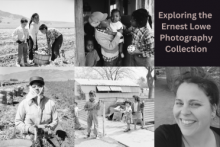Heather Devrick is a lecturer in the Merritt Writing Program (MWP) and a current graduate student pursuing a Master in Library and Information Science (MLIS) through San Jose State. We spoke with her recently to ask about her pursuit of an MLIS and use of the Ernest Lowe Photography collection to complete an archival assignment.
The Ernest Lowe Photography Collection features Lowe’s work documenting the lives and struggles of farm working communities in California’s Central Valley in the 1960s and captures prominent labor activists including Cesar Chavez and Dolores Huerta.
Q: What made you pursue an MLIS? Where are you at in your program?
Though I loved books and libraries at an early age, I seriously started considering an MLIS program during the MWP/Library TRAIL (Teaching Research and Information Literacy) collaboration. In this initiative to embed information literacy into a first-year writing course, I was struck by the processes required for both writing and research. Since that time, I have been working with students to not only develop their writing skills but also find their inner researcher. Currently, I am about halfway through the MLIS program.
Q: What was your assignment and what prompted your decision to use the Ernest Lowe Photography Collection to complete it?
I was required to curate an exhibit based on an archival collection and though I was allowed to choose any digital collection for this project, I knew I wanted to select a collection that highlighted the Valley. I was aware of the UC Merced Library’s focus on creating a Sierra Nevada-Central Valley Archive, so I reached out to my library colleagues for an introduction to available collections. University Archivist Jerrold Shiroma introduced me to digitized UC Merced Library and Special Collections available through Calisphere including the Ernest Lowe Photography Collection. Jerrold also followed up by providing an article on Black farming communities in the Central Valley for additional context.
Q: What was challenging about crafting an exhibit concept?
Curating an exhibit requires that you take a lot of information and make sense of it. This approach reminded me of TRAIL where we emphasized with students that you start with a question not with an answer. My questions included, “What stories are here? What stories have been under told?”
Just like any research process, I had to find a focus and theme. Originally, I thought I might feature photographs of abandoned buildings (as there are so many of them in Lowe’s work!) but instead I decided to curate photographs of children of migrant farmworkers. I intentionally made selections that showcased children from multiple locations, participating in varied activities, (such as working, playing, attending school), and belonging to different communities.
It was perhaps most difficult to limit my choices to a mere 30 photographs! I was also challenged to place a hard-stop to my research. There is so much more in the archives waiting to be explored and discussed.
Q: What did you learn/discover through this project?
Through this project I was first introduced to Calisphere and was amazed by how much digital content was available. The Ernest Lowe Collection alone has 2,700 photographs. I learned more about Lowe’s work and discovered that the UC Berkeley School of Journalism hosted a 2013 exhibit titled Don’t Cry For Me Babey which featured Lowe’s photos of family and children laborers.
To better understand the collection, I found myself researching individuals, events, communities, and organizations. The metadata for each photograph varied, so my research involved trying to verify people and places in order to provide accurate information about each item. For many photographs, I was able to supplement the metadata.
I learned more about Black Okie communities like Teviston and the role of individuals like Maria Moreno in this region’s labor activism. For instance, she attended AFL-CIO (American Federation of Labor and Congress of Industrial Organizations) convention in Florida (1961) to argue for reinstated funding for the Agricultural Workers Organizing Committee (AWOC); she was successful. Overall, I was struck by how many people were involved in the labor movement -- both those who are well-known and others who were never in the spotlight. As featured in the photographs, children were part of this endeavor as parents took them to important farmworker labor events.
Q: What would you want others to know about archives, digital collections, or this Ernest Lowe collection based on your work?
I want people to know what we are doing at UC Merced with the establishment of a Sierra Nevada-Central Valley Archive. We are bringing together unique sources from our region and making them accessible to anyone. With these collections, we can surface stories we didn’t know were there. They speak to the Valley’s existence and importance.

View images selected from the Ernest Lowe Photography Collection for Devrick's Curatorial Project (2:04)

